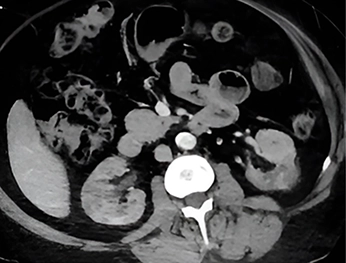Lightning Bolt® 7 Case Study: Rapid Revascularization of Bilateral Renal Artery Occlusion with Computer Assisted Vacuum Thrombectomy (CAVT™)

Lightning Bolt 7 is Penumbra’s first application of modulated aspiration designed to address conditions such as acute limb ischemia (ALI), hibernating thrombus, and artery occlusions. Computer Assisted Vacuum Thrombectomy, CAVT, including Lightning Bolt 7, is designed to be quick, safe, and potentially used without the need for thrombolysis or open surgery.
An illustrative case of Lightning Bolt 7 comes from Dr. Dan Clair, Vascular Surgeon, and Dr. Hossam Alslaim, Clinical Fellow, at Vanderbilt University Medical Center, Nashville, TN.
Case Study
A 61-year-old female presented to the hospital with acute back pain and renal failure. The patient was diabetic, with a history of hypertension, heart failure, atrial fibrillation on oral anticoagulation, and coronary artery disease. A CT scan showed bilateral renal artery occlusion. Given her condition, Drs. Clair and Alslaim planned an endovascular revascularization approach and chose Lightning Bolt 7 for thrombus removal with the goal of rapid vessel revascularization.
Intervention
Utilizing a femoral approach, a combination of 7 F deflectable sheath with hydrophilic wire and crossing catheter were used to access the right renal artery. Angiographic imaging confirmed occlusion of the renal stent with some flow into the distal renal arterial branches (Figure 1). Lightning Bolt, which pairs modulated aspiration with a 7 F, stainless steel, hypotube catheter, was advanced over the .035-inch wire into the ostium of the renal artery. The atraumatic catheter tip design allowed advancement into the secondary renal artery branches. Figure 2 shows improvement in renal cortical enhancement and patency of the second order renal branches. Residual stenosis was identified in the distal end of the previously placed renal stent, which was realigned with a self-expanding stent (Figure 3). The same process was repeated on the left renal artery with similar results. Imaging confirmed patent renal artery stent with good parenchymal enhancement on delayed phase (Figure 4).

Conclusion
The use of Lightning Bolt 7 restored flow to both kidneys quickly and effectively as an endovascular solution. While the use of thrombolysis or surgical embolectomy could be considered here, the speed of revascularization would be difficult to match, and we believe this device and approach offered the opportunity to preserve some renal function in this clinical situation.
Important Safety Information
Additional information about Penumbra’s CAVT products can be located on Penumbra’s website at https://www.penumbrainc.com/products/peripheral-thrombectomy-indigo-system/. Caution: Federal (USA) law restricts these devices to sale by or on the order of a physician. Prior to use, please refer to Instructions for Use for complete product indications, contraindications, warnings, precautions, potential adverse events, and detailed instructions for use. Risk information can be found at peninc.info/risk.
Images used with permission. Consent on file at Penumbra, Inc. Procedural and operative techniques and considerations are illustrative examples from physician experience. Physicians’ treatment and technique decisions will vary based on their medical judgment. The clinical results presented herein are for informational purposes only, and may not be predictive for all patients. Individual results may vary depending on patient-specific attributes and other factors.
Related Articles
-
 Product, Neuro, Clinical, Health
Product, Neuro, Clinical, HealthMIND IDE Trial of Penumbra’s Artemis Neuro Evacuation Device Shows Potential Promise for Patients Experiencing Hemorrhagic Stroke
February 20, 2025 -
 Vascular, Product, Health
Vascular, Product, HealthPenumbra Launches ElementTM Vascular Access System – the First Laser-Cut Hypotube Sheath Designed for Venous Thromboembolism
January 29, 2025 -
 Clinical, Vascular, Product, Health
Clinical, Vascular, Product, HealthLightning Bolt® 6X with TraXTM Case Study: Revascularization of Tibioperoneal Artery with Computer Assisted Vacuum Thrombectomy (CAVTTM)
January 27, 2025 -
 Health
HealthAnnouncing Lightning Bolt® 12 and Lightning Bolt 6X with TraX™ – Newest Additions to Penumbra’s CAVT™ Platform for the Management of Arterial and Venous Thrombus
January 22, 2025
